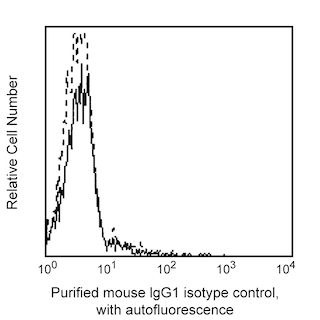Old Browser
Looks like you're visiting us from {countryName}.
Would you like to stay on the current country site or be switched to your country?




Flow cytometric analysis of CD220 expression on human peripheral blood monocytes. Human whole blood was stained with either Purified Mouse Anti-Human CD220 (Cat. No. 559954; solid line histogram) or Purified Mouse IgG1, κ Isotype Control (Cat. No. 555746; dashed line histogram), followed by FITC Goat Anti-Mouse IgG/IgM (Cat. No. 555988). Erythrocytes were lysed with BD Pharm Lyse™ Lysing Buffer (Cat No. 555899). Fluorescent histograms were derived from gated events with the side and forward light-scattering characteristics of intact monocytes.


BD Pharmingen™ Purified Mouse Anti-Human CD220

Regulatory Status Legend
Any use of products other than the permitted use without the express written authorization of Becton, Dickinson and Company is strictly prohibited.
Preparation And Storage
Product Notices
- An isotype control should be used at the same concentration as the antibody of interest.
- Caution: Sodium azide yields highly toxic hydrazoic acid under acidic conditions. Dilute azide compounds in running water before discarding to avoid accumulation of potentially explosive deposits in plumbing.
- Please refer to www.bdbiosciences.com/us/s/resources for technical protocols.
- Since applications vary, each investigator should titrate the reagent to obtain optimal results.
- Sodium azide is a reversible inhibitor of oxidative metabolism; therefore, antibody preparations containing this preservative agent must not be used in cell cultures nor injected into animals. Sodium azide may be removed by washing stained cells or plate-bound antibody or dialyzing soluble antibody in sodium azide-free buffer. Since endotoxin may also affect the results of functional studies, we recommend the NA/LE (No Azide/Low Endotoxin) antibody format, if available, for in vitro and in vivo use.
Companion Products





.png?imwidth=320)
The 3B6 monoclonal antibody specifically recognizes the Insulin Receptor (IR), a glycoprotein composed of two extracellular α-subunits (130 kDa) and two transmembrane β-subunits (95 kDa). It is expressed on human hematopoietic and non-hematopoietic cells, but unlike the insulin-like growth factor receptor (IGF-IR), which is ubiquitous, the insulin receptor is restricted to major target tissues of insulin action. Upon binding insulin, the IR subunits form a heterotetramer of two α and two β subunits resulting in autophosphorylation and activation of the tyrosine kinase activity of the receptor. This ligand-receptor interaction is important in regulating cell metabolism and growth. 3B6/IR monoclonal antibody reacts similarly to anti-human IR α, clone 47-9, an α-subunit antibody.
Development References (4)
-
Brindle NP, Tavare JM, Dickens M, Whittaker J, Siddle K. Anti-(insulin receptor) monoclonal antibody-stimulated tyrosine phosphorylation in cells transfected with human insulin receptor cDNA. Biochem J. 1990; 268(3):615-620. (Biology). View Reference
-
Prigent SA, Stanley KK, Siddle K. Identification of epitopes on the human insulin receptor reacting with rabbit polyclonal antisera and mouse monoclonal antibodies. J Biol Chem. 1990; 265(17):9970-9979. (Biology). View Reference
-
Soos MA, O'Brien RM, Brindle NP, et al. Monoclonal antibodies to the insulin receptor mimic metabolic effects of insulin but do not stimulate receptor autophosphorylation in transfected NIH 3T3 fibroblasts.. Proc Natl Acad Sci USA. 1989; 86(14):5217-21. (Biology). View Reference
-
Soos MA, Siddle K, Baron MD, et al. Monoclonal antibodies reacting with multiple epitopes on the human insulin receptor.. Biochem J. 1986; 235(1):199-208. (Biology). View Reference
Please refer to Support Documents for Quality Certificates
Global - Refer to manufacturer's instructions for use and related User Manuals and Technical data sheets before using this products as described
Comparisons, where applicable, are made against older BD Technology, manual methods or are general performance claims. Comparisons are not made against non-BD technologies, unless otherwise noted.
For Research Use Only. Not for use in diagnostic or therapeutic procedures.
Refer to manufacturer's instructions for use and related User Manuals and Technical Data Sheets before using this product as described.
Comparisons, where applicable, are made against older BD technology, manual methods or are general performance claims. Comparisons are not made against non-BD technologies, unless otherwise noted.
Report a Site Issue
This form is intended to help us improve our website experience. For other support, please visit our Contact Us page.